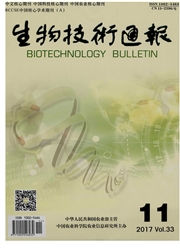

 中文摘要:
中文摘要:
利用适当的策略激活粤蓝链霉菌中潜在的隐性次级代谢途径,以期获得新的活性物质。以粤蓝链霉菌突变株DMR1为研究对象,该突变株的主导产物榴菌素的关键生物合成基因gra-orf1-3被敲除,不能产生榴菌素。通过改变营养条件、添加诱导物和热激等方法处理菌株,利用琼脂糖扩散法及TLC-生物显影等方法检测发酵粗提物的抑菌活性。结果显示,突变株DMR1的高氏一号和ISP3培养基发酵粗提物对枯草芽孢杆菌ATCC6633、金黄色葡萄球菌ATCC6538以及耐药的金黄色葡萄球菌ATCC43300和206具有显著抑菌活性;添加3%DMSO诱导后,高氏一号和ISP3培养基的发酵粗提物不仅对上述菌株的抑制活性增强,还具有抑制大肠杆菌ATCC8739、白色念珠菌ATCC10231以及多株耐药菌大肠杆菌和沙门氏菌的活性。粤蓝链霉菌中新发现的活性物质对革兰氏阳性菌、革兰氏阴性菌以及酵母菌具有广泛的抗菌活性,且部分发酵粗提物对所有测试的耐药菌均具有显著活性,有可能是新型的抗生素。结果也表明"移树养苗"策略能够提高隐性活性次级代谢产物的挖掘效率。
 英文摘要:
英文摘要:
This study aims to discover novel bioactive substances by activating the cryptic biosynthetic gene clusters of secondarymetabolites from Streptomyces vietnamensis with appropriate strategies. The study was carried out in a S. vietnamensis mutant DMR1. In thismutant,the key biosynthetic genes,gra-orf1-3,of the dominant product were knocked out,resulting in deficiency in granaticin production.The strain was subject to nutrient condition changing,inducer adding and heat shocking. The antimicrobial activities of the fermentationcrude extracts were tested using agarose diffusion method and TLC-bioautography. Results showed that the fermentation crude extracts ofGause No.1 and ISP3 presented significant inhibitory effects against Bacillus subtilis ATCC6633,Staphylococcus aureus ATCC6538 as wellas multidrug resistant Staphylococcus aureus strains ATCC43300 and 206. With adding 3% DMSO to the media,not only did the activities ofthe fermentation crude extracts of Gause No.1 and ISP3 against the afore said strains increase,but also the spectrum broadened into againstEscherichia coli ATCC8739,Candida albicans ATCC10231 and multidrug resistant E. coli and Salmonella sp. strains. The newly discoveredbioactive substances from S. vietnamensis showed extensive activities against both gram-positive and gram-negative bacteria as well as yeast.More importantly,some of the crude extracts were significantly active against all the tested drug-resistant strains. These results indicate apossibility of a novel type of antibiotic. The results presented in this paper illustrate that the so-called ‘tree-removal' strategy can improve themining efficiency of the cryptic bioactive secondary metabolites.
 同期刊论文项目
同期刊论文项目
 同项目期刊论文
同项目期刊论文
 期刊信息
期刊信息
